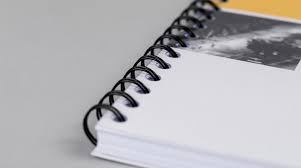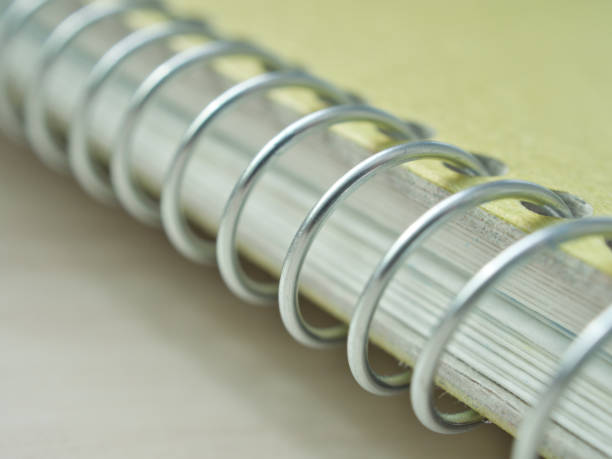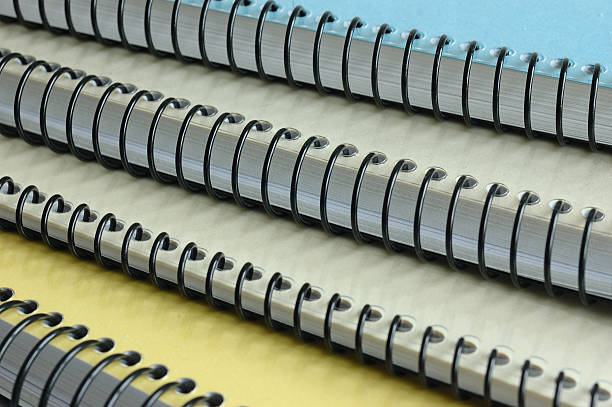
The choice of binding is crucial for professional-looking publications. Spiral bound booklets stand out as a versatile and practical option. They are ideal for manuals, guides, and other materials needing a durable, functional design. Their 360-degree opening and ability to lay flat make them perfect for everyday use.
Additionally, users can have their cover printed using various materials such as cardstock, emphasizing the aesthetic appeal and personalization possibilities that come with spiral binding.
In Australia, spiral binding is a favourite among businesses. It offers a sleek, polished finish that elevates the look of any project. Whether it’s a company handbook, training manual, or product catalogue, spiral binding adds a professional touch. The durable plastic coils resist distortion, ensuring a long-lasting binding solution. This is suitable for a wide range of page counts, from 8 to 300 pages.
Introduction to Spiral Bound Booklets
Definition and Overview
Spiral binding, or coil binding, is a widely used method. It employs a plastic coil or wire to bind the cover and printed pages. This coil is threaded through holes in the spine, allowing the booklet to open fully and stay flat.
Advantages of Spiral Bound Booklets
Spiral bound booklets have several advantages. These make them a preferred choice for many uses. Key benefits include:
- 360-degree opening and easy page turning, enabling a lay-flat design
- Economical cost for short production runs
- Durable plastic coils that resist distortion and damage
- Quick turnaround times for production
- Professional appearance and a sleek, quality finish
Additionally, spiral binding can handle more pages without compromising the booklet’s integrity, making it ideal for larger documents.
These booklets are ideal for manuals, guides, cookbooks, presentations, and reports. Their functionality, durability, and professional look make them highly valued.
| Spiral Coil Size | Page Count Range |
|---|---|
| JC100LE – JC108LE, 200B – 210B | 12 – 300 pages |
The versatility of spiral binding allows for customization. Options include coil color, cover material, and finishing touches. This ensures the booklet aligns with the desired aesthetic and branding.
Types of Spiral Bound Booklets
Exploring spiral bound booklets reveals two main binding styles: plastic coil and wire binding. Each style boasts its own set of benefits, ensuring your printed materials look professional and polished.
Plastic Coil Binding
Plastic coil binding, or spiral binding, employs a continuous plastic coil. It’s threaded through holes in the booklet’s spine. This method allows for a 360-degree opening and ensures the booklet lies flat, making it ideal for manuals and guides. The plastic coils are available in a variety of colours, enabling you to align with your brand’s look.
Wire Binding
Wire binding, or twin loop wire binding, uses separate wire loops through the spine’s holes. It presents a more industrial yet refined appearance compared to plastic coil binding. Although it offers fewer colour options, wire binding still provides the 360-degree opening and lay-flat functionality that spiral bound booklets are known for.
| Binding Style | Appearance | Customization | Functionality |
|---|---|---|---|
| Plastic Coil Binding | Sleek and modern | Wide range of coil colours | 360-degree opening, lay-flat |
| Wire Binding | Industrial and refined | Limited coil colour options | 360-degree opening, lay-flat |
Key Features of Spiral Bound

Spiral bound booklets stand out due to their 360-degree opening and lay-flat functionality. This feature is crucial for manuals, guides, and reference materials. It ensures users can easily access specific pages or sections without straining the spine.
The durability and resistance to distortion of plastic coils or wire loops are notable. These elements help maintain the booklet’s professional appearance, even with frequent use. With a maximum of 920 pages using a 2-inch diameter coil, they are ideal for a broad spectrum of projects.
Customization is another significant advantage of spiral binding. Booklets can be tailored with various coil colours, cover materials, and finishes. This flexibility allows businesses to align their printed materials with their branding and design, enhancing the overall professional look.
| Feature | Benefit |
|---|---|
| 360-degree opening and lay-flat functionality | Allows the booklet to remain flat when open, making it easy to access specific pages or sections. |
| Durable plastic coils or wire loops | Resist distortion and maintain the booklet’s professional appearance, even with frequent use. |
| Customizable coil colours, cover materials, and finishes | Enable businesses to create a cohesive and polished look for their printed materials. |
| Accommodates a wide range of page counts | Suitable for projects with up to 920 pages using a 2-inch diameter coil. |
In summary, spiral bound booklets are a versatile and practical choice for various professional applications. They are ideal for business reports, manuals, cookbooks, and presentations, thanks to their key features.
Printing Options
When it comes to printing spiral bound booklets, the choices you make can significantly impact the final product. One of the most crucial decisions is selecting the type of paper for the internal pages. Options range from glossy and matte to textured finishes, each offering a unique look and feel. Glossy paper can make images pop, while matte provides a more subdued, professional appearance. Textured finishes add a tactile element that can enhance the reader’s experience.
In addition to paper type, the quality and color of the ink used for printing are vital. High-quality ink ensures that text and images are sharp and vibrant, making your booklet more engaging. Many printing services also offer the option to print the cover in full color, which can create a lasting impression and elevate the overall look of your booklet. Whether you opt for a simple black-and-white interior or a full-color extravaganza, the right printing choices can make your spiral bound booklet stand out.
Page Count and Layout Considerations
Designing a spiral bound booklet requires careful consideration of both page count and layout. The page count directly influences the thickness of the booklet, which in turn affects its usability. A general rule of thumb is to keep the page count to a maximum number of 300 pages. This ensures that the booklet remains easy to handle and that the pages stay intact, even with frequent use.
The layout of your booklet is equally important. Proper margins, font size, and image placement can make a significant difference in readability and overall aesthetics. Ensure that the text is clear and legible, and that images are well-placed to complement the content. A well-thought-out layout not only enhances the user experience but also ensures that the booklet lies flat and is easy to navigate. By paying attention to these details, you can create a spiral bound booklet that is both functional and visually appealing.
Applications and Use Cases
Spiral bound booklets are versatile and practical, fitting various needs. They’re ideal for manuals, guides, cookbooks, and presentations. Their benefits make them a favourite among businesses and individuals.
Manuals and Guides
For manuals and guides, spiral bound booklets are a top pick. Their lay-flat design makes for easy reference and frequent use. The durable construction keeps pages intact, even with regular handling.
Spiral binding is often used in safety training, employee handbooks, and technical guides. It offers a professional yet functional look for instructional materials.
Cookbooks and Recipes
Cookbooks and recipe collections benefit greatly from spiral bound booklets. The lay-flat feature allows for easy following of recipes. It prevents damage to the spine, making it perfect for home cooks and chefs.
Presentations and Reports
Spiral bound booklets are also popular for presentations and reports. They provide a sleek, modern look. The lay-flat design enhances functionality, making them ideal for meetings and client presentations.
Customization Options for Spiral Bound Booklets
Spiral bound booklets open up a realm of customization, enabling you to craft a product that stands out. You can choose from a variety of cover materials and finishes, coil colours, and sizes. This vast array of options lets you align your booklets with your brand’s identity and needs.
Cover Materials and Finishes
The cover of your booklet can range from basic poly covers to premium options like full-colour printed covers on 80 or 120 gsm stock. To add a touch of elegance, consider specialty finishes like lamination, die-cutting, and foiling. These enhancements can significantly boost the booklet’s professional look.
Coil Colors and Sizes
Choosing the coil binding involves a wide range of colours, allowing you to match your brand’s palette. The coil size can be adjusted to fit the booklet’s page count, ensuring a seamless fit and optimal functionality. Popular sizes include 8.5″x11″, 8.5″x5.5″, and 6″x9.
Whether you’re producing manuals, guides, or any other type of booklet, the customization options are vast. This allows you to create a product that is not only professional but also polished and branded. Such a product is sure to leave a lasting impression on your audience.
Cost Implications
The cost of producing spiral bound booklets can vary based on several factors, including page count, paper stock, and printing quality. Generally, spiral bound booklets are more cost-effective than other binding methods, such as perfect binding. This makes them an attractive option for businesses and individuals looking to produce high-quality materials without breaking the bank.
However, it’s essential to consider additional costs that may arise. For instance, opting for a full-color cover or using premium paper stock can increase the overall expense. It’s a good idea to get quotes from multiple printing services to compare prices and find the best option for your budget. While spiral binding is generally economical, understanding the cost implications of your choices can help you make informed decisions and stay within your budget.
Ease of Use and Accessibility
Spiral bound booklets are designed with ease of use and accessibility in mind. The plastic coil binding allows the pages to lay flat, making it easy to read and write on them. This binding style is particularly beneficial for manuals and guides, where users need to refer to specific sections frequently. The lay-flat design ensures that the booklet remains open to the desired page without needing to hold it down.
Additionally, the plastic coil binding makes it easy to turn the pages, which is ideal for everyday use. The durable construction ensures that the pages stay intact, even with frequent handling. This makes spiral bound booklets perfect for environments where they will be used often, such as classrooms, kitchens, and offices. The combination of functionality and durability makes spiral bound booklets a practical choice for a wide range of applications.
Durability and Longevity of Spiral Bound Booklets

Spiral bound booklets are celebrated for their outstanding durability and lasting performance. They are perfect for materials that will be used often. The plastic coils or wire loops in the binding process resist distortion, keeping the booklet’s shape intact. This ensures the pages stay securely in place, preventing tears or looseness over time.
The lay-flat design of these booklets adds to their durability and functionality. This design allows the booklet to handle everyday use without losing its professional look or usability. Users can open the booklet fully and rotate the pages 360 degrees, making it easier to handle and saving space.
Spiral binding coils come in various diameters, from 1/4″ to 2″. This range supports page counts from 4 pages to 1.75″ thick blocks. This flexibility ensures the booklet meets specific project needs, staying durable and functional.
Moreover, the plastic coils are 100% waterproof. This makes spiral bound booklets perfect for wet or damp environments, such as outdoor use or restaurants with splash-prone areas. This feature boosts the booklet’s durability and longevity, ensuring it withstands its intended use without losing integrity.
In summary, spiral bound booklets are a dependable and cost-effective option for many applications. They are ideal for manuals, guides, cookbooks, and presentations. Their ability to endure frequent use and maintain a professional appearance makes them a favourite choice for projects needing both functionality and quality.
Production Process of Spiral Bound Booklets
The creation of professional spiral bound booklets is a detailed process. It combines top-notch digital printing with precise binding methods. The first step is printing the cover and interior pages, ensuring vivid colours and clear text. After the materials are printed, the spiral binding begins.
Printing and Binding Methods
The spiral binding process starts with punching holes along the spine edge of the pages. A plastic coil or wire loop is then threaded through these holes, binding the pages together. The coil or wire ends are crimped to prevent unravelling, offering a durable finish.
Quality Control
Quality control is strict throughout the production to ensure the highest standards. Each step, from printing to binding, is closely monitored. This ensures consistent quality and a professional look.
Spiral binding is a favourite among bookbinding methods. It offers flexibility, ease of use, and a modern appearance. Through a thorough production process, spiral bound booklets become a versatile solution for various projects. These include manuals, guides, cookbooks, and presentations.
Tips for Creating Effective Spiral Bound Booklets
Creating an effective spiral bound booklet involves several key considerations:
- Choose a high-quality paper stock: Durable and easy-to-handle paper ensures that your booklet withstands frequent use.
- Select an appropriate binding style: Ensure the binding style matches your page count and layout for optimal functionality.
- Consider a full-color cover: A vibrant, full-color cover can make a lasting impression and enhance the booklet’s professional appearance.
- Use a clear and concise layout: Ensure that the text is easy to read and that images are well-placed to complement the content.
- Keep the page count manageable: Aim for a maximum of 300 pages to ensure the booklet lies flat and is easy to handle.
- Opt for a professional finish: Glossy or matte finishes can give your booklet a polished, professional look.
By following these tips, you can create spiral bound booklets that are not only effective and professional but also easy to use. The right choices in paper stock, binding style, and layout can make a significant difference, ensuring that your booklet leaves a lasting impression on your audience.
Conclusion
In conclusion, spiral bound booklets are a versatile and practical solution for various print projects. They range from manuals and guides to cookbooks and presentations. The durable construction, lay-flat design, and ability to accommodate different page counts and customization options stand out. Spiral bound booklets offer a professional, polished appearance, enhancing the brand image and functionality of your materials. This makes them a preferred choice for both businesses and individuals.
Looking to create an instruction manual, catalogue, or report? Spiral binding is an excellent option, combining style and substance. The durability and flexibility of spiral bound booklets make them ideal for everyday use. They ensure a lasting impression and frequent use for your projects.
With numerous customization options, from cover materials and finishes to coil colors and sizes, you can craft a sleek, professional-looking product. It will truly reflect your brand’s identity. If you seek a binding method that balances quality, style, and functionality, consider the versatile and reliable spiral bound booklet.








